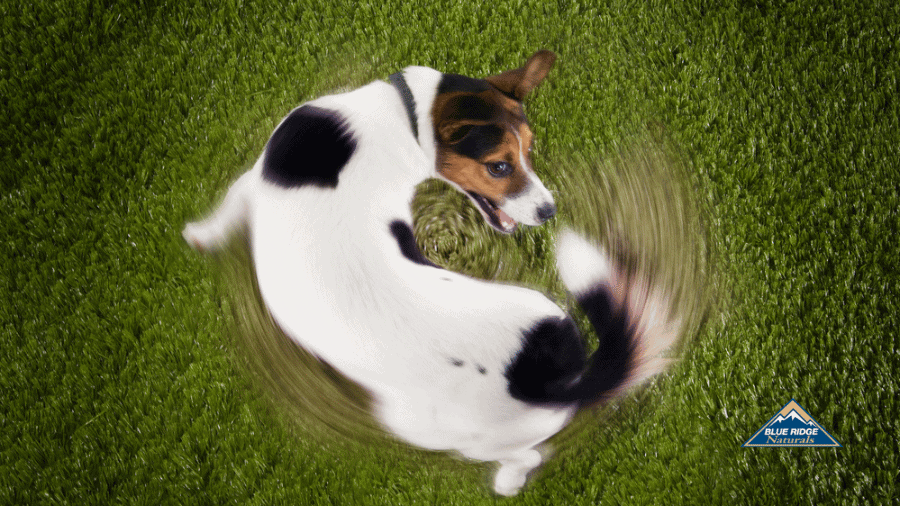There’s nothing more fulfilling than having a furry friend in the family! But being a dog owner comes with a lot of responsibility, too. Whether you adopt or bring home a puppy, you’ll soon learn that your beloved pup has a distinct personality and quirks to go with it. Those quirks make Rocco, well…Rocco. But there are some habits that most dogs seem to share; like tilting their head to the side with curiosity, wagging their tail when they’re happy, or even chasing their tail. Speaking of that last habit, that’s actually the purpose of our blog post. If your dog is chasing its tail and you’re not sure why, you’ve come to the right place.
Here at Blue Ridge Naturals, we’re all about your dog’s health: inside and out. We’ll help you get to the bottom of this compulsive behavior in no time. Let’s dive right in!
Isn’t My Dog Just Playing?
If your dog chases his or her tail, you might be wondering: is my dog just playing? It’s true that many breeds of dogs do find tail-chasing to be an entertaining pastime. Puppies especially often chase their tail as a form of exploration. It’s a common way for them to have fun and get rid of all that excess energy they have!
Another factor you’ll want to consider is the breed of your canine companion. Some breeds of dogs chase their tails more often than others (like German shepherds or bull terriers for example), at least that’s generally thought to be true.

Attention-Seeking Behaviors
For dogs, chasing their tail can sometimes be an attention-seeking behavior. Like people, our four-legged friends need a lot of love! Many humans find a dog’s tail-chasing behaviors entertaining, and dogs can pick up on this. They’ll start chasing their tails more and more to get a reaction.
Although this behavior can be cute, it could also indicate an underlying health issue. That’s why it’s important to observe your dog and be aware of its habits. You can also shower your pup with other kinds of attention to prevent tail-chasing. Our Sweet Potato Bones are a nutrient-packed treat that will keep your dog happy (and occupied for a few seconds)! To really occupy their time, consider breaking our treats into smaller pieces and hiding them in different compartments of a dog puzzle toy. Your dog will get a treat, while also releasing some of that pent-up energy.
Your Dog Is Stressed or Anxious
Did you know that dogs can get stressed or anxious, too? That’s right. We, humans, aren’t the only ones who let our emotions get to us. As dog owners, we want to ensure our furry friends are safe and happy whenever possible. If your dog is chasing its tail, how can you be sure it’s not feeling anxious?
When dogs get anxious, they often chew or lick their tails. Pay attention to what’s going on when your dog engages in these behaviors. Are there new people around, or frightening sounds? These environmental factors could be making your dog anxious or stressed. By observing your furry companion, you can help it feel safe and secure in any environment.
Why is my Dog Chasing Their Tail? Is There Something Wrong?
As we’ve discussed, when dogs chase their tails, it’s often harmless. But this isn’t always the case. Sometimes tail-chasing, chewing, or biting, is a sign of a larger problem.
Compulsive tail chasing is known to be a sign of infection in some dogs. In particular, this compulsion has been linked to the presence of intestinal parasites. Dogs will chew or bite at their tails to try and soothe the infection. Ouch.
The good news is, there’s a noticeable difference between a dog playing with its tail and biting at it. You’ll likely be able to tell whether the tail-chasing is because of an underlying issue. What should you do if you think your dog may be suffering from intestinal parasites? Make sure to contact their vet, even if you aren’t sure. It’s always better safe than sorry when it comes to our furry friends!

Could it Be a Compulsive Behavior?
Sometimes a dog will chase their tail because of a compulsive disorder. But what causes these compulsive behaviors like this, and tail chewing?
Obsessive-compulsive disorder can sometimes develop in dogs. In the dog world, we call this Canine Compulsive Disorder. This condition can develop in all breeds of dogs, although it appears more often in herding dogs. There are treatments available for dogs with compulsive disorders. Make sure to contact a professional if you think this might be the case with your canine companion.
Another cause of these compulsions in dogs is a lack of exercise or physical activity. Dogs can get bored when they’re under-exercised, which could lead to compulsive behavior.
When Tail Chasing Is No Longer Entertaining – How to Replace Unwanted Behavior
When your dog first starts chasing their tail, it can seem like a cute little trick. We get it. There’s nothing more exciting than when your furry friend adopts a quirky new habit.
But sometimes, our furry friends can take the tail-chasing a little too far. Especially if they’re chasing their tail as a compulsion, it can become too much. So how can you help your mutt out with behavior modification, and put an end to this unwanted habit?
If the behavior has to do with a medical condition, you should seek professional help. Your vet can prescribe medication, or recommend a training routine.
In less severe cases, you may be able to treat the tail-chasing yourself! Positive reinforcement is a great way to reward your dog for a job well done. Our Salmon Topper Trainer Treats are the perfect addition to your dog’s daily routine.
Tail Chasing: The Good, The Bad, and The Ugly
As we’ve learned, when dogs chase their tails, it’s usually okay. But it isn’t always a good thing. Tail-chasing can also be a sign of anxiety, infection, or compulsive behavior.
When choosing what’s right for your furry friend, it’s important to put their health first. You don’t want to take any chances when it comes to your dog’s well-being. Here at Blue Ridge Naturals, we’re passionate about caring for our four-legged family. Your dog deserves the best, and we’re here to help you give them that.
Although tail-chasing is often harmless, it’s important to keep an eye out in case that changes. By knowing the warning signs, such as escalated tail-biting or chewing, you can step in when your pup needs it.
Want to learn more about dog care? Read “Puppy Plays Too Rough? How To Fix It”


